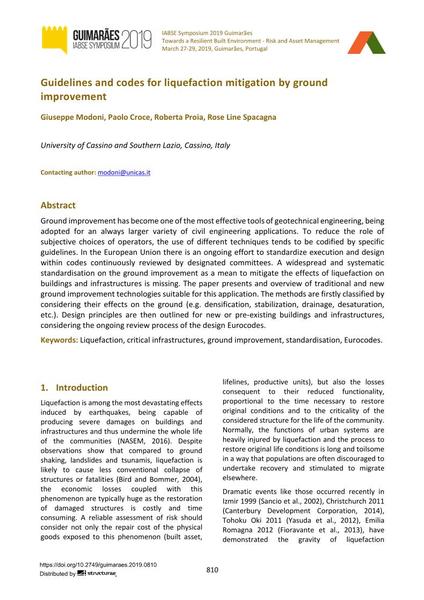Guidelines and codes for liquefaction mitigation by ground improvement

|
|
|||||||||||
Bibliographic Details
| Author(s): |
Giuseppe Modoni
(University of Cassino and Southern Lazio, Cassino, Italy)
Paolo Croce (University of Cassino and Southern Lazio, Cassino, Italy) Roberta Proia (University of Cassino and Southern Lazio, Cassino, Italy) Rose Line Spacagna (University of Cassino and Southern Lazio, Cassino, Italy) |
||||
|---|---|---|---|---|---|
| Medium: | conference paper | ||||
| Language(s): | English | ||||
| Conference: | IABSE Symposium: Towards a Resilient Built Environment Risk and Asset Management, Guimarães, Portugal, 27-29 March 2019 | ||||
| Published in: | IABSE Symposium Guimarães 2019 | ||||
|
|||||
| Page(s): | 810-817 | ||||
| Total no. of pages: | 8 | ||||
| DOI: | 10.2749/guimaraes.2019.0810 | ||||
| Abstract: |
Ground improvement has become one of the most effective tools of geotechnical engineering, being adopted for an always larger variety of civil engineering applications. To reduce the role of subjective choices of operators, the use of different techniques tends to be codified by specific guidelines. In the European Union there is an ongoing effort to standardize execution and design within codes continuously reviewed by designated committees. A widespread and systematic standardisation on the ground improvement as a mean to mitigate the effects of liquefaction on buildings and infrastructures is missing. The paper presents and overview of traditional and new ground improvement technologies suitable for this application. The methods are firstly classified by considering their effects on the ground (e.g. densification, stabilization, drainage, desaturation, etc.). Design principles are then outlined for new or pre-existing buildings and infrastructures, considering the ongoing review process of the design Eurocodes. |
||||
| Keywords: |
liquefaction ground improvement standardisation Eurocodes critical infrastructures
|
||||
